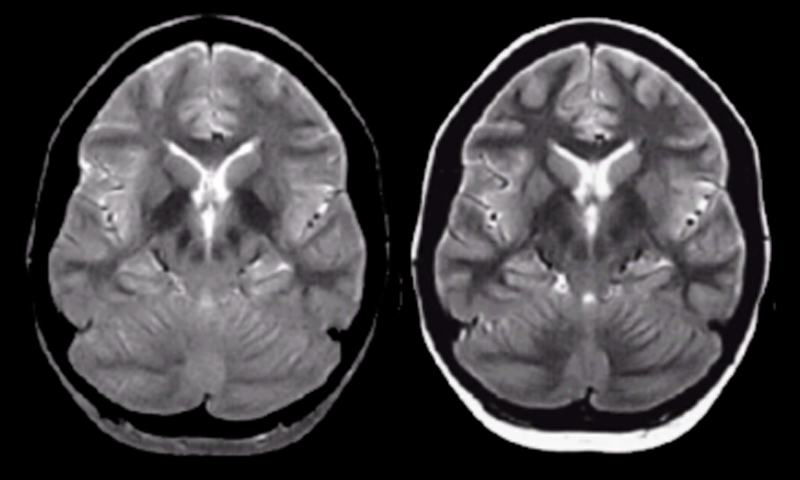|
When fast spin-echo (FSE) sequences first came into use in the 1990s, the most striking difference compared to conventional spin-echo (CSE) was "abnormally" bright fat seen on the FSE images. This phenomenon is pictured right.
|
I know this statement requires some some further background and explanation, so please try to follow the discussion below!
Advanced Discussion (show/hide)»
Although most authorities consider disruption of J-coupling to be the primary mechanism responsible for bright fat, additional factors may also be important. Henkelman et al have suggested the closely-spaced RF-pulses reduce diffusion-mediated dephasing as spins diffuse through regions with different local magnetic field suceptibilities (fat and water). Stimulated echoes from the multiple RF-pulses may also explain perhaps 10% of the bright fat effect. Mulkern et al have shown that the degree of relative fat signal increase has a field dependence, being relatively more prominent at 1.5T than at higher or lower fields. Since J-coupling is independent of field strength, this implies other mechanisms may be operational.
In any case I have wondered whether this question is still even relevant to the modern generation of MR users. FSE imaging has largely replaced CSE in nearly all aspects of MRI. Fat on FSE images no longer seems "abnormally" bright, since FSE has become the "new normal". Perhaps this discussion is now mostly of historical interest. In any case, the bright fat phenomenon on FSE does explain why we typically do fat-suppressed T2-weighted images routinely, whereas fat suppression was not commonly employed on CSE T2-weighted images in the "old days".
Henkelman RM, Hardy PA, Bishop JE, Poon CS, Plewes DB. Why fat is bright in RARE and fast spin-echo imaging. J Magn Reson Imaging 1992; 2: 533-540.
Mulkern RV, Packard AB, Gambarota G. Field dependence of the bright fat effect in fast spin echo imaging: theory and experiment. Proc Intl Soc Mag Reson Med 2003; 11:1107.
Stables LA, Kennan RP, Anderson AW, Gore JC. Density matrix simulations of the effects of J coupling in spin echo and fast spin echo imaging. J Magn Reson 1999;140:305-314.
Stokes AM, Feng Y, Mitropoulos T, Warren WS. Enhanced refocusing of fat signals using optimized multipulse echo sequences. Magn Reson Med 2013;69;1044-55.
What is Fast (Turbo) spin echo imaging?



